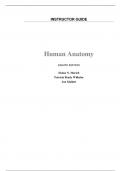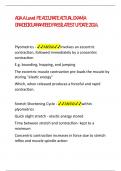INSTRUCTOR GUIDE
Human Anatomy
EIGHTH EDITION
Elaine N. Marieb
Patricia Brady Wilhelm
Jon Mallatt
, CHAPTER
The Human Body:
1 An Orientation
Lecture and Demonstration
Objectives
1. Define anatomy and physiology, and describe the subdisciplines of anatomy.
2. Use the meaning of word roots to aid in understanding anatomical terminology.
3. Identify the levels of structural organization in the human body, and explain the interrela-
tionships between each level.
4. List the organ systems of the body, and briefly state the functions.
5. Use metric units to quantify the dimensions of cells, tissues, and organs.
6. Define anatomical position.
7. Use anatomical terminology to describe body directions, regions, and planes.
8. Describe the basic structures that humans share with other vertebrates.
9. Locate the major body cavities and their subdivisions.
10. Name the four quadrants of the abdomen, and identify the visceral organs located within
each quadrant.
11. Explain how human tissue is prepared and examined for its microscopic structure.
12. Distinguish tissues viewed by light microscopy from those viewed by electron
microscopy.
13. Describe the medical imaging techniques that are used to visualize structures inside the
body.
Suggested Lecture Outline
I. An Overview of Anatomy (pp. 2–6)
A. Subdisciplines of Anatomy (p. 2)
1. Gross anatomy studies the human body structures with the naked eye, and dissection is
the major technique. In systemic anatomy, organs with related functions are studied
together. Professional schools study anatomy by the regional approach: All organs and
structures in a single region are studied as a group. The third subdivision is surface
anatomy, which studies the landmarks on the surface of the body that reveal underly-
ing organs.
2. Microscopic anatomy (also called histology) uses the microscope to study specially
prepared tissue slides.
Copyright © 2014 Pearson Education, Inc. 1
, 3. Developmental anatomy explores how body structures form, grow, and mature
throughout their life span.
4. Embryology is the study of how the human body structures form and develop before
birth.
B. The Hierarchy of Structural Organization (pp. 2-6, Figs. 1.1, 1.2)
1. Structural Organization (pp. 2–6)
a. The levels of structural organization, from the simplest to the most complex, are
as follows: chemical, cellular, tissue, organ, organ system, and the human organism
itself.
b. Organ systems are organs working closely together to accomplish a common func-
tion. The body’s organ systems are the integumentary, skeletal, muscular, nervous,
endocrine, cardiovascular, lymphatic, immune, respiratory, digestive, urinary, and
reproductive systems.
C. Scale: Length, Volume, and Weight (p. 6)
1. The metric system provides precision for measuring the dimensions of cells, tissues,
and organs.
D. Anatomical Terminology (p. 6)
1. Ancient Greek and Latin provide the origins for most anatomical terms.
II. Gross Anatomy: An Introduction (pp. 6–13)
A. The Anatomical Position (p. 6)
1. Learning the anatomical position is essential because directional terminology used in
anatomy refers to the body in this position.
B. Regional and Directional Terms (pp. 6–7, Fig. 1.3, Table 1.1)
1. Regional terms name the specific body areas.
2. The standardized terms of direction are: superior/inferior; anterior (ventral)/posterior
(dorsal); medial/lateral; and superficial/deep.
C. Body Planes and Sections (pp. 7 and 10, Fig. 1.4)
1. The body and/or organs are cut into sections along a flat surface called a plane.
2. Planes are identified as sagittal, frontal (coronal), transverse (horizontal), and oblique.
3. Sagittal planes are midsagittal (median) planes or parasagittal planes.
D. The Human Body Plan (pp. 10–11, Fig. 1.6)
1. Tube-within-a-tube
2. Bilateral symmetry
3. Dorsal hollow nerve cord
4. Notochord and vertebrae
5. Segmentation
6. Pharyngeal pouches
E. Body Cavities and Membranes (pp. 11–13, Figs. 1.6, 1.7)
1. The dorsal body cavity is subdivided into the cranial cavity and the vertebral cavity.
a. The cranial cavity houses the brain.
b. The vertebral cavity runs through the vertebral column and encloses the spinal cord.
2 INSTRUCTOR’S RESOURCE GUIDE FOR HUMAN ANATOMY, 7e Copyright © 2014 Pearson Education, Inc.
, 2. Three serous cavities are all enclosed body cavities with no openings to the external
surface of the body.
a. The pericardial cavity surrounds the heart.
b. The pleural cavity surrounds the lung.
c. The peritoneal cavity surrounds abdominopelvic viscera.
F. Abdominal Quadrants (pp. 13, Fig. 1.8)
1. The abdomen is divided into four quadrants: the right upper quadrant, the left upper
quadrant, the right lower quadrant, and the left lower quadrant.
G. Anatomical Variability (p. 13)
1. Anatomical structures do not always match the textbook descriptions.
III. Microscopic Anatomy: An Introduction (pp. 13–15, Fig. 1.9)
A. Microscopy is the examination of the fine structure of organs, tissues, and cells.
(pp. p. 13)
B. Preparing Human Tissue for Microscopy (pp. 13–14)
1. Specimens for LM or TEM must be fixed (preserved) and then cut into sections (slic-
es) thin enough to transmit light or electrons.
C. Scanning electron microscopy provides three-dimensional pictures of whole, unsectioned
surfaces. (p. 15)
D. Preserved tissue that has been exposed to many procedures can show minor distortions
called artifacts. (p. 15)
IV. Clinical Anatomy: An Introduction to Medical Imaging Techniques (pp. 15–19,
Figs. 1.10–1.14)
A. X-Ray Imaging (pp. 15–16, Fig. 1.10)
1. Traditional X-ray images continue to play a major role in medical diagnoses involving
bone and abnormal dense structures, such as a tumor.
B. Advanced X-Ray Techniques (pp. 16–17, Figs. 1.11, 1.12)
1. Computed tomography (CT) or computed axial tomography (CAT) produces
improved X-ray images that are computer enhanced for clarity.
2. Mammography is an imaging technique that uses low-dose radiation to examine the
breast for tumors.
3. Angiography is an imaging technique that utilizes a contrast medium injected into a
blood vessel to produce clear images of blood vessels. Angiography is important for
diagnosing diseases and disorders of blood vessels.
4. Digital subtraction angiography (DSA) provides an unobstructed view of small arter-
ies. Images of vessels are taken before and after injection of contrast medium. Com-
puter technology allows for the “before” image to be “subtracted,” yielding clear
images of potential blockages in vessels to the heart or brain.
C. Positron emission tomography (PET) tracks radioisotopes in the body, locating areas of
high energy consumption and high blood flow. (pp. 17, Fig. 1.13)
D. Sonography (ultrasound imaging) provides sonar images of developing fetuses and inter-
nal body structures, such as an enlarged liver. (p. 18, Fig. 1.14)
Copyright © 2014 Pearson Education, Inc. CHAPTER 1 The Human Body: An Orientation 3





